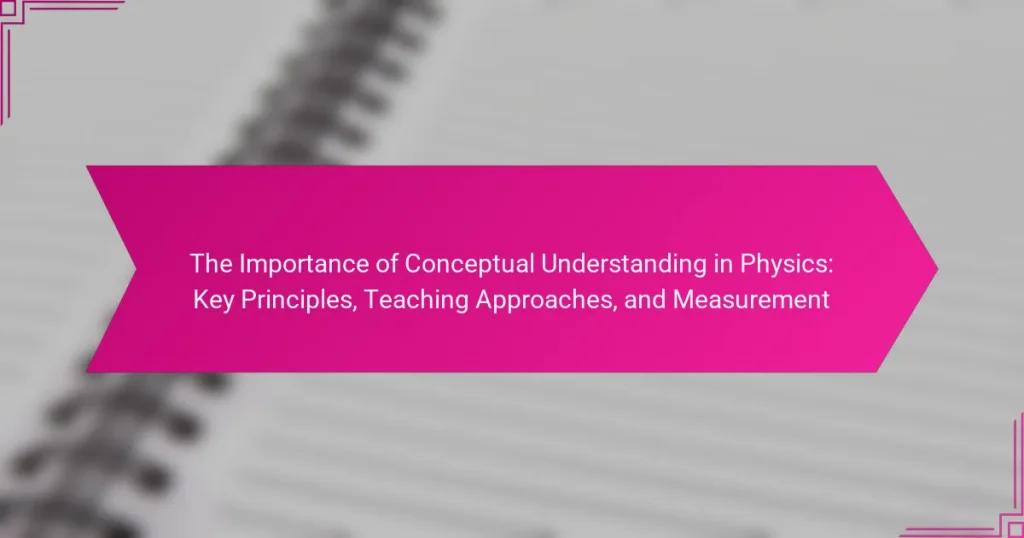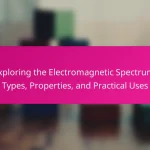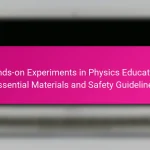Conceptual understanding in physics is essential for students to grasp fundamental principles and apply them to real-world scenarios. This understanding enhances critical thinking and problem-solving skills, leading to improved performance in physics assessments. Active learning strategies, such as problem-based, inquiry-based, and collaborative learning, significantly enhance this conceptual understanding, as evidenced by research indicating higher exam scores among students engaged in these methods. Various assessment tools, including the Force Concept Inventory and open-ended questions, are utilized to measure students’ conceptual understanding and identify misconceptions, providing a comprehensive evaluation of their grasp of physics concepts.
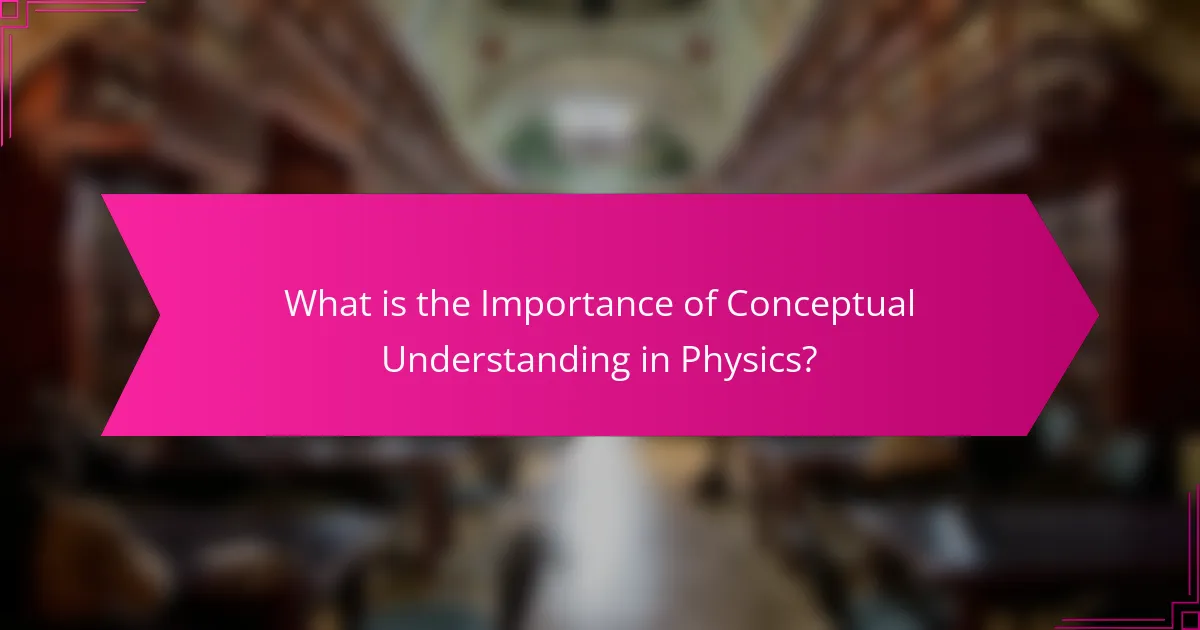
What is the Importance of Conceptual Understanding in Physics?
Conceptual understanding in physics is crucial for grasping fundamental principles and applying them to real-world situations. It enables students to connect abstract concepts with concrete examples. This understanding fosters critical thinking and problem-solving skills. Research indicates that students with strong conceptual frameworks perform better in physics assessments. For instance, a study by Hestenes et al. (1992) demonstrated that students who engaged in conceptual learning showed significant improvements in their understanding of mechanics. Thus, a solid conceptual foundation is essential for success in physics education and practical applications.
Why is conceptual understanding crucial for learning physics?
Conceptual understanding is crucial for learning physics because it enables students to grasp underlying principles. This understanding helps them connect different concepts and apply them to various problems. Without a solid conceptual foundation, students may struggle with problem-solving and critical thinking. Research indicates that students who focus on conceptual understanding perform better in physics assessments. For instance, studies show that students with strong conceptual skills can transfer knowledge to new situations effectively. Thus, fostering conceptual understanding leads to deeper learning and retention of physics concepts.
How does conceptual understanding differ from rote memorization?
Conceptual understanding involves grasping the underlying principles and relationships in a subject. Rote memorization focuses on memorizing facts without understanding their significance. Conceptual understanding allows for application and transfer of knowledge to new situations. Rote memorization often leads to forgetting information once it is no longer needed. Research shows that students with conceptual understanding perform better in problem-solving tasks in physics. A study by Hake (1998) found that conceptual learning approaches significantly improve student performance compared to traditional methods.
What role does conceptual understanding play in problem-solving?
Conceptual understanding is crucial in problem-solving as it enables individuals to grasp underlying principles. This understanding allows for the application of knowledge to new situations. When students comprehend concepts, they can identify relevant information and formulate strategies effectively. Research indicates that students with strong conceptual understanding perform better in problem-solving tasks. For example, a study by Hattie (2009) highlights that conceptual knowledge significantly enhances students’ ability to tackle complex problems. Thus, conceptual understanding directly influences the efficiency and accuracy of problem-solving.
What are the key principles of conceptual understanding in physics?
Key principles of conceptual understanding in physics include the ability to apply concepts to real-world situations. This involves recognizing patterns and relationships within physical phenomena. Understanding fundamental principles allows for better problem-solving skills. It also encourages critical thinking and the ability to make predictions based on known information. Moreover, conceptual understanding fosters the integration of knowledge across different physics topics. Research shows that students with strong conceptual understanding perform better in assessments. This is supported by studies indicating that deep comprehension leads to greater retention of knowledge.
Which fundamental concepts underpin conceptual understanding in physics?
The fundamental concepts that underpin conceptual understanding in physics include energy, force, motion, and the laws of thermodynamics. Energy is the capacity to do work and exists in various forms such as kinetic and potential energy. Force is an interaction that causes an object to change its velocity, described by Newton’s laws of motion. Motion refers to the change in position of an object over time, which can be analyzed using concepts like velocity and acceleration. The laws of thermodynamics govern the principles of energy transfer and transformation in physical systems. These concepts are foundational in developing a coherent understanding of physical phenomena and are essential for problem-solving in physics.
How do these principles relate to real-world applications?
Conceptual understanding in physics principles directly relate to real-world applications by enabling problem-solving and innovation. These principles help students grasp fundamental concepts like force, energy, and motion. For example, understanding Newton’s laws allows engineers to design safer vehicles. Knowledge of thermodynamics is crucial for developing efficient engines and refrigerators. Real-world applications also include predicting weather patterns using fluid dynamics principles. Furthermore, these principles are essential in medical imaging technologies, such as MRI, which rely on electromagnetic theory. Thus, a strong conceptual foundation in physics supports advancements across multiple industries.
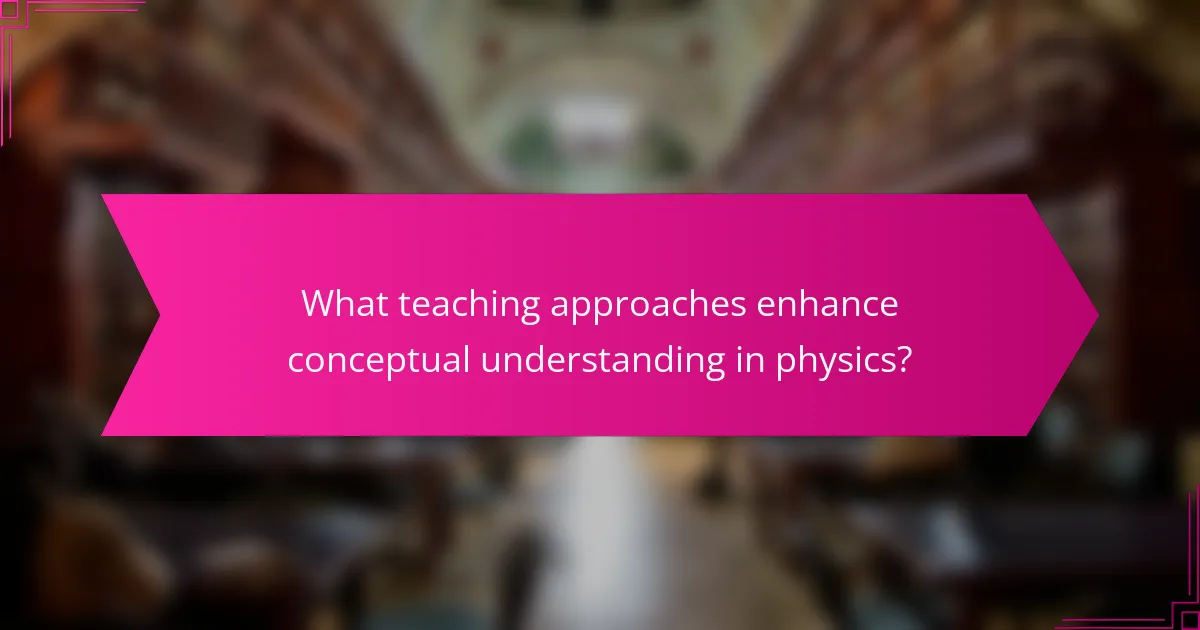
What teaching approaches enhance conceptual understanding in physics?
Active learning strategies enhance conceptual understanding in physics. These approaches engage students in the learning process. Techniques such as problem-based learning promote critical thinking. Inquiry-based learning encourages exploration and questioning. Collaborative learning fosters peer discussion and idea exchange. Research indicates that these methods lead to deeper comprehension. Studies show that students who engage in active learning outperform those in traditional lectures. For instance, a meta-analysis by Freeman et al. (2014) revealed a significant increase in exam scores. The findings support the effectiveness of these teaching approaches in physics education.
How can inquiry-based learning improve conceptual understanding?
Inquiry-based learning enhances conceptual understanding by promoting active engagement in the learning process. This approach encourages students to ask questions, investigate, and construct knowledge through exploration. Research indicates that students involved in inquiry-based learning demonstrate deeper comprehension of complex concepts. A study by Minner et al. (2010) found that inquiry-based methods lead to improved critical thinking and problem-solving skills. Furthermore, inquiry-based learning fosters connections between theoretical knowledge and real-world applications. This method allows learners to apply concepts in practical scenarios, reinforcing their understanding. Overall, inquiry-based learning serves as an effective strategy for enhancing students’ conceptual grasp in subjects like physics.
What are the characteristics of effective inquiry-based learning in physics?
Effective inquiry-based learning in physics encourages active student engagement. It fosters critical thinking and problem-solving skills. Students explore concepts through hands-on experiments and real-world applications. Collaboration among peers enhances understanding and knowledge sharing. Teachers facilitate rather than direct learning, promoting student autonomy. Assessments focus on understanding rather than rote memorization. This approach aligns with research indicating that active learning improves retention and comprehension. Studies show that inquiry-based methods lead to deeper conceptual understanding compared to traditional instruction.
How does collaborative learning contribute to deeper understanding?
Collaborative learning enhances deeper understanding by facilitating active engagement among students. It encourages discussion, which allows learners to articulate their thoughts and clarify their understanding. Students benefit from diverse perspectives, leading to a more comprehensive grasp of complex concepts. Research shows that collaborative learning can improve retention rates and critical thinking skills. A study by Johnson and Johnson (2009) indicates that students involved in collaborative learning outperform their peers in individual settings regarding conceptual understanding. This method fosters a supportive environment where learners can ask questions and receive immediate feedback. Overall, collaborative learning transforms passive learning into an interactive experience, significantly deepening comprehension.
What role does technology play in teaching conceptual understanding?
Technology enhances teaching conceptual understanding by facilitating interactive learning experiences. It allows for simulations and visualizations that make abstract concepts tangible. For instance, physics simulations enable students to manipulate variables and see real-time effects. This experiential learning fosters deeper comprehension. Research by the National Research Council indicates that technology can improve student engagement and motivation. Engaged students are more likely to grasp complex ideas. Additionally, tools like educational software provide immediate feedback, which helps learners identify misconceptions. Overall, technology serves as a bridge between theory and practice in teaching conceptual understanding.
How can simulations and visualizations aid in learning physics concepts?
Simulations and visualizations enhance learning physics concepts by providing interactive and visual representations of abstract ideas. They allow students to manipulate variables and observe outcomes in real-time. This interactive engagement fosters deeper understanding and retention of complex concepts. Studies show that students who use simulations perform better in physics assessments. Research by the National Research Council indicates that visual aids improve comprehension of motion and forces. Simulations also cater to diverse learning styles, making physics accessible to more students. Overall, they bridge the gap between theory and practical application in physics education.
What are the benefits of using interactive tools in physics education?
Interactive tools enhance physics education by promoting active engagement among students. They facilitate hands-on learning experiences that deepen understanding. Students can visualize complex concepts through simulations and interactive models. This approach caters to diverse learning styles, making physics more accessible. Research indicates that interactive tools improve retention and application of knowledge. A study by Hake (1998) found that interactive engagement methods can increase student learning gains significantly. Additionally, these tools encourage collaboration and discussion, fostering a community of learners. Overall, using interactive tools leads to improved academic performance and a greater appreciation for physics.
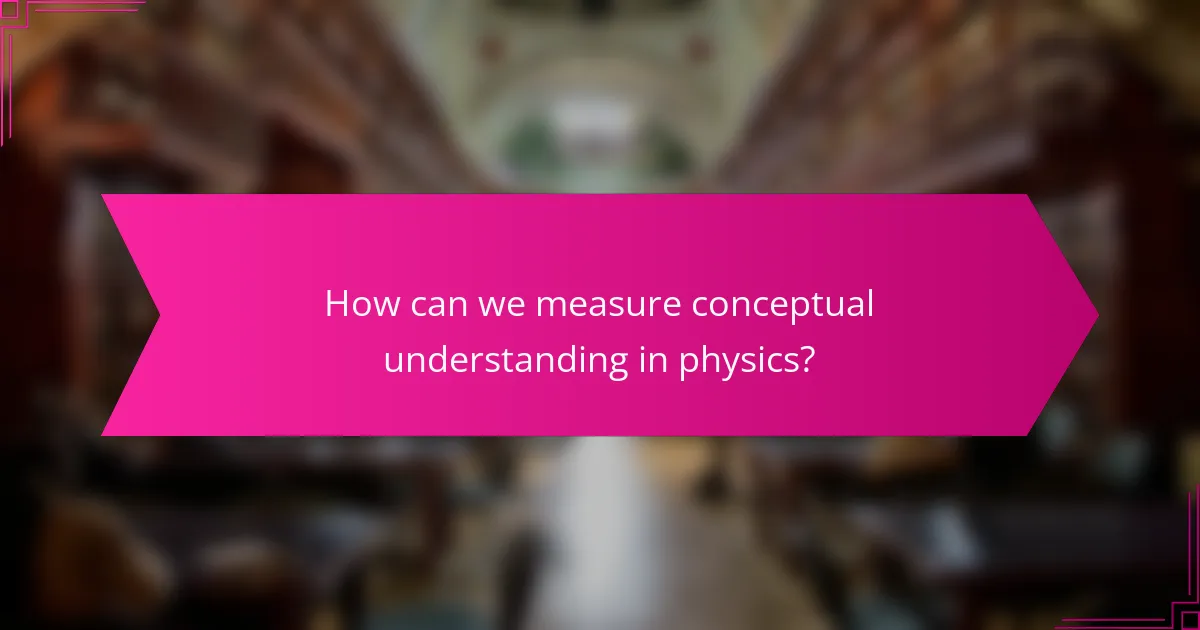
How can we measure conceptual understanding in physics?
Conceptual understanding in physics can be measured using various assessment tools. These include conceptual questionnaires and diagnostic tests. The Force Concept Inventory (FCI) is a widely used tool for assessing understanding of fundamental physics concepts. Research shows that FCI effectively identifies students’ misconceptions. Another method is through open-ended questions that require explanation of concepts. This approach assesses depth of understanding and reasoning skills. Additionally, performance-based assessments can evaluate application of concepts in practical scenarios. Studies indicate that diverse assessment methods provide a comprehensive view of students’ conceptual understanding.
What assessment methods effectively gauge conceptual understanding?
Formative assessments effectively gauge conceptual understanding. These assessments include quizzes, discussions, and reflective journals. They provide immediate feedback on student comprehension. Research shows that formative assessments improve learning outcomes. A study by Black and Wiliam (1998) found that formative assessment can raise student achievement significantly. Performance tasks also measure conceptual understanding. These tasks require students to apply knowledge in real-world scenarios. Concept maps are another effective method. They visually represent relationships between concepts, aiding in understanding. Finally, peer assessments encourage collaborative learning and critical thinking.
How do formative assessments contribute to understanding?
Formative assessments enhance understanding by providing ongoing feedback to both students and educators. These assessments identify areas where students struggle, allowing for timely intervention. They help track student progress over time, fostering a deeper grasp of concepts. Research shows that formative assessments can lead to improved academic performance. For instance, a study by Hattie and Timperley (2007) indicates that feedback from formative assessments significantly impacts student learning outcomes. Additionally, formative assessments encourage active engagement and self-reflection among learners. This active participation aids in solidifying knowledge and promotes a growth mindset. Overall, formative assessments are essential tools in the educational process, contributing to a more profound understanding of subject matter.
What are the advantages of using concept maps for assessment?
Concept maps enhance assessment by visually representing relationships between concepts. They promote deeper understanding by requiring students to organize knowledge hierarchically. This method encourages critical thinking as students analyze and synthesize information. Research shows that concept maps improve retention of material and facilitate recall. A study by Novak and Gowin (1984) indicates that students who use concept maps perform better in assessments. Additionally, concept maps provide immediate feedback for both instructors and learners. They highlight misconceptions, guiding targeted interventions for improvement. Overall, concept maps serve as effective tools for evaluating conceptual understanding in educational settings.
What challenges exist in measuring conceptual understanding?
Measuring conceptual understanding presents several challenges. One significant challenge is the variability in individual interpretations of concepts. Different students may understand and apply concepts in diverse ways. This variability complicates the assessment process.
Additionally, traditional testing methods often focus on rote memorization rather than deep understanding. This can lead to misleading results regarding a student’s actual conceptual grasp. Furthermore, the abstract nature of many concepts in physics makes it difficult to create effective assessment tools.
Another challenge is the influence of prior knowledge on new learning. Students with different backgrounds may approach concepts from varying perspectives. This can affect their performance on assessments designed for a more uniform understanding.
Finally, assessing conceptual understanding often requires open-ended questions or problem-solving tasks. These formats can be time-consuming to evaluate and may introduce subjectivity in grading. Thus, measuring conceptual understanding remains a complex and multifaceted issue in educational settings.
How can educators overcome common obstacles in assessment?
Educators can overcome common obstacles in assessment by utilizing diverse assessment methods. Incorporating formative assessments allows for continuous feedback and adjustment of teaching strategies. Using rubrics provides clear expectations and consistency in grading. Collaborative assessments encourage peer feedback and enhance understanding. Implementing technology can streamline the assessment process and facilitate data analysis. Professional development equips educators with effective assessment techniques. Research shows that varied assessment approaches can improve student engagement and learning outcomes.
What strategies can be implemented to improve measurement accuracy?
Implementing calibration techniques is essential to improve measurement accuracy. Regular calibration of instruments ensures that they provide precise readings. Utilizing high-quality equipment reduces the margin for error. Training personnel in proper measurement techniques enhances consistency. Employing statistical methods to analyze measurement data helps identify systematic errors. Implementing environmental controls minimizes external factors that could affect results. Following standardized procedures ensures uniformity across measurements. These strategies collectively contribute to increased reliability and validity in measurements.
What best practices can enhance conceptual understanding in physics education?
Active learning strategies enhance conceptual understanding in physics education. These strategies include problem-based learning, where students engage in solving real-world problems. Research shows that students retain knowledge better when applying concepts in practical scenarios. Collaborative learning also promotes understanding through peer discussions and group problem-solving. According to a study by Hake (1998), interactive engagement methods significantly improve student performance in physics. Additionally, using visual aids and simulations helps illustrate complex concepts. This multimodal approach caters to different learning styles, making physics more accessible. Regular formative assessments provide feedback, allowing instructors to address misconceptions promptly. Overall, these best practices create an engaging learning environment that fosters deeper comprehension of physics concepts.
The main entity of the article is conceptual understanding in physics. The article emphasizes the significance of conceptual understanding for grasping fundamental physics principles, enhancing problem-solving skills, and improving academic performance. It explores key principles underpinning this understanding, effective teaching approaches such as active and inquiry-based learning, and the role of technology and collaborative methods in education. Additionally, the article addresses various assessment strategies to measure conceptual understanding, highlighting challenges and best practices for educators to foster deeper learning in physics.
